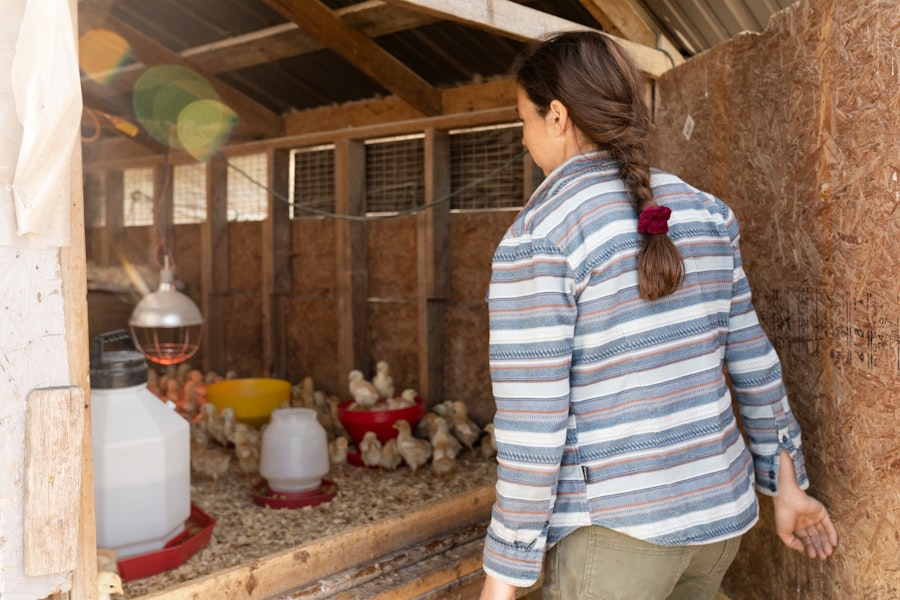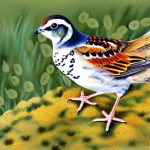Button quail, also known as Chinese painted quail, are small, ground-dwelling birds that are popular among aviculturists for their charming appearance and easy care. Button quail chicks are particularly adorable and endearing, making them a favorite among bird enthusiasts. These tiny chicks are just a few inches in size and come in a variety of colors, including silver, cinnamon, and white. They are known for their quick movements and curious nature, making them a joy to watch and care for.
Button quail chicks are relatively easy to breed and raise, making them a great choice for beginners in aviculture. They are also a popular choice for those with limited space, as they can be kept in small enclosures. However, despite their small size, button quail chicks require proper care and attention to thrive. In this article, we will explore the process of breeding and caring for button quail chicks, from selecting breeding stock to feeding and rearing the chicks. Whether you are a seasoned aviculturist or a beginner looking to start a new hobby, this guide will provide you with the information you need to successfully breed and raise button quail chicks.
Table of Contents
Key Takeaways
- Button quail chicks are small, ground-dwelling birds that are popular for their unique appearance and low maintenance.
- When selecting breeding stock, look for healthy, active birds with no signs of illness or deformities.
- Setting up a breeding environment involves providing a suitable nesting area, proper lighting, and a balanced diet for the breeding pair.
- Incubating button quail eggs requires a stable temperature, high humidity, and regular turning of the eggs for successful hatching.
- Caring for button quail chicks involves providing a warm, draft-free brooder, clean bedding, and access to fresh water and chick starter feed.
Selecting Breeding Stock
Selecting the right breeding stock is crucial for successful button quail chick breeding. When choosing breeding stock, look for healthy, active birds with bright eyes, smooth feathers, and a lively demeanor. Avoid birds that appear lethargic or have any signs of illness or injury. It’s also important to select birds that are of breeding age, which is typically around 3-4 months old. Breeding too early can result in health problems for the birds and their offspring.
In addition to physical health, it’s important to consider the genetic diversity of the breeding stock. Inbreeding can lead to genetic defects and health issues in the offspring, so it’s best to avoid breeding closely related birds. Look for unrelated birds with diverse genetic backgrounds to ensure the health and vitality of the chicks. Finally, consider the color variations of the birds when selecting breeding stock. If you have a specific color variation in mind, choose birds that exhibit those traits to produce offspring with the desired coloration. By carefully selecting breeding stock based on health, age, genetic diversity, and color variations, you can set the stage for successful button quail chick breeding.
Setting Up a Breeding Environment
Creating the right breeding environment is essential for successful button quail chick breeding. Start by providing a suitable enclosure for the breeding pair, such as a spacious cage or aviary with plenty of room for the birds to move around. The enclosure should have a solid floor to prevent injury to the chicks and be equipped with nesting boxes or shelters where the female can lay her eggs in privacy.
It’s important to provide the birds with a comfortable and stress-free environment to encourage breeding behavior. This includes providing appropriate substrate for nesting, such as soft bedding material or grass hay. Additionally, ensure that the enclosure is kept at the right temperature and humidity levels for breeding. Button quail chicks thrive in warm, humid conditions, so maintaining a temperature of around 75-80°F (24-27°C) and humidity levels of 60-70% is ideal for breeding success.
Finally, consider the lighting in the breeding environment. Button quail are sensitive to changes in light and require a consistent day-night cycle to stimulate breeding behavior. Provide 12-14 hours of daylight followed by 10-12 hours of darkness to mimic natural light cycles and encourage the birds to breed. By creating a suitable breeding environment with the right enclosure, nesting materials, temperature, humidity, and lighting, you can help your button quail pair feel comfortable and ready to breed.
Once your button quail pair has successfully bred and laid eggs, it’s time to move on to the next stage of the breeding process: incubating the eggs. Button quail eggs require specific conditions to hatch successfully, so it’s important to provide the right environment for the eggs during the incubation period. Start by carefully collecting the eggs from the nesting box and transferring them to an incubator set at the appropriate temperature and humidity levels.
Button quail eggs should be incubated at a temperature of around 99-100°F (37-38°C) and a humidity level of 40-50%. It’s important to monitor these conditions closely throughout the incubation period to ensure the eggs develop properly. Turning the eggs several times a day is also crucial to prevent the embryos from sticking to the shell membrane and promote even development.
The incubation period for button quail eggs is relatively short, typically lasting around 16-18 days before hatching. During this time, it’s important to keep a close eye on the eggs and make any necessary adjustments to the temperature and humidity levels as needed. By providing the right conditions for incubating button quail eggs, you can increase the chances of a successful hatch and ensure healthy chicks.
Once the button quail chicks have hatched, it’s important to provide them with proper care and attention to ensure their health and well-being. The chicks are initially very small and delicate, so it’s crucial to handle them with care and provide a safe and nurturing environment for their development. Start by transferring the newly hatched chicks to a brooder box equipped with a heat source, such as a heat lamp or heating pad, to maintain a warm temperature of around 95-100°F (35-38°C) for the first week of their lives.
It’s important to monitor the chicks closely during this time and make sure they have access to fresh water and chick starter feed formulated specifically for young quail. Keep the brooder box clean and dry to prevent any health issues or infections from developing. Additionally, provide plenty of space for the chicks to move around and explore while ensuring they are protected from drafts or disturbances.
As the chicks grow, gradually reduce the temperature in the brooder box by 5°F (2-3°C) each week until they are fully feathered and able to regulate their body temperature. At this point, they can be transferred to a larger enclosure with appropriate bedding material and enrichment items for mental stimulation. By providing attentive care and creating a nurturing environment for button quail chicks, you can help them thrive and develop into healthy adults.

Feeding and rearing button quail chicks requires careful attention to their nutritional needs at each stage of development. From hatching to adulthood, button quail chicks require a balanced diet rich in protein, vitamins, and minerals to support their growth and development. Start by providing newly hatched chicks with chick starter feed formulated specifically for young quail, which contains high levels of protein essential for their rapid growth.
As the chicks grow, gradually introduce other foods into their diet, such as finely chopped greens, mealworms, and small seeds. It’s important to provide a varied diet to ensure they receive all the essential nutrients they need for healthy development. Additionally, make sure they have access to clean water at all times to prevent dehydration.
As the chicks mature into adults, transition them onto a diet suitable for adult button quail, which typically includes a mix of game bird feed, seeds, greens, and occasional treats such as mealworms or small insects. Providing a balanced diet throughout their development is crucial for their long-term health and well-being.
In addition to their diet, it’s important to provide appropriate housing and enrichment items for rearing button quail chicks. This includes providing a spacious enclosure with suitable bedding material, hiding spots, perches, and toys for mental stimulation. By meeting their nutritional needs and providing a stimulating environment, you can ensure that your button quail chicks grow into healthy adults.
Breeding button quail chicks can be a rewarding experience when done successfully. To increase your chances of success, consider these tips for successful button quail chick breeding:
1. Provide a suitable breeding environment: Create a comfortable and stress-free environment for your breeding pair with appropriate nesting materials, temperature, humidity levels, and lighting.
2. Select healthy breeding stock: Choose healthy, active birds with diverse genetic backgrounds and desirable color variations for breeding.
3. Monitor incubation conditions: Maintain consistent temperature and humidity levels during incubation while turning the eggs regularly to promote even development.
4. Provide attentive care: Handle newly hatched chicks with care and provide them with a warm brooder box equipped with food, water, and heat source.
5. Meet nutritional needs: Offer a balanced diet rich in protein, vitamins, and minerals at each stage of development to support healthy growth.
6. Create a stimulating environment: Provide appropriate housing and enrichment items for rearing button quail chicks to promote mental stimulation and physical activity.
By following these tips and providing proper care throughout the breeding process, you can increase your chances of successfully breeding and rearing button quail chicks. With dedication and attention to detail, you can enjoy watching these charming birds grow from adorable chicks into healthy adults in your care.
If you’re interested in breeding button quail chicks, you may also want to check out Poultry Wizard’s article on choosing the right flooring for your chicken coop. Proper flooring is essential for creating a healthy and comfortable environment for your quail chicks as they grow. Understanding the best flooring options can help ensure the success of your breeding efforts.
FAQs
Button quail chicks are typically bred in a controlled environment, such as a breeding cage or aviary. The process involves providing the appropriate nesting materials, ensuring a balanced diet, and maintaining the proper temperature and humidity levels for the eggs to hatch.
Button quail eggs typically take about 16-18 days to hatch. It is important to monitor the eggs closely during this time to ensure they are developing properly.
Button quail chicks should be fed a diet that consists of high-quality chick starter feed, as well as small insects and finely chopped greens. It is important to provide a balanced diet to ensure the chicks grow and develop properly.
Ideal breeding conditions for button quail chicks include a temperature range of 98-100 degrees Fahrenheit, as well as a humidity level of around 60-70%. It is also important to provide a quiet and stress-free environment for the breeding pair.
To ensure the health and well-being of button quail chicks, it is important to provide a clean and spacious environment, as well as a balanced diet and access to fresh water. Regular monitoring and observation of the chicks is also crucial to identify any potential health issues early on.
Meet Walter, the feathered-friend fanatic of Florida! Nestled in the sunshine state, Walter struts through life with his feathered companions, clucking his way to happiness. With a coop that’s fancier than a five-star hotel, he’s the Don Juan of the chicken world. When he’s not teaching his hens to do the cha-cha, you’ll find him in a heated debate with his prized rooster, Sir Clucks-a-Lot. Walter’s poultry passion is no yolk; he’s the sunny-side-up guy you never knew you needed in your flock of friends!







